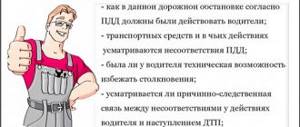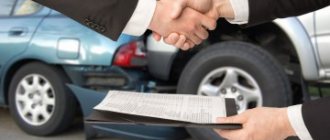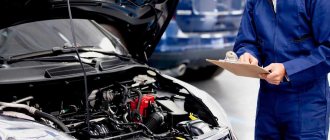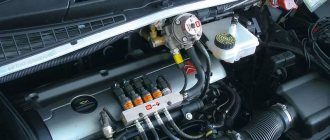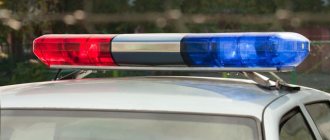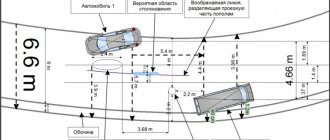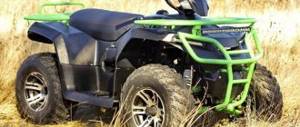After an accident, the car owner wants to find out the real amount of damage caused to his car. Such information can only be obtained by conducting an independent assessment of the vehicle.
Why is it needed?
The purpose of an automotive technical examination is always determined by the need to obtain a specialist’s professional judgment on certain questions, which are impossible to answer without special training, education or instrumental research.
The help of a “professional witness,” as an expert is sometimes called, is resorted to by investigative bodies and courts when they consider it necessary to confirm the circumstances of the case with an expert opinion or when it is impossible to establish any fact without it.
Participants in the incident submit questions for auto technical examination to confirm their arguments about the circumstances of the case or substantiate objections to the arguments of the other party.
In some cases, to resolve specific issues, a special analysis is required. Thus, in accordance with Article 12.1 of the Federal Law No. 40-FZ dated April 25, 2002, an independent technical examination must be carried out to establish:
- circumstances of damage to the car;
- its damage;
- causes of breakdowns;
- technology, methods and cost of car restoration.
Examination methods
All examinations are carried out according to certain methods known to licensed specialists. These techniques overlap with forensic ones and borrow many techniques from there.
Thus, the expert examines the accident site, takes photographs and videos, records and measures traces of the accident, the location of the vehicle, and the location of the wreckage. The condition of the road and roadside structures is assessed. Damaged vehicles are inspected: they are identified and damage (internal and external) is recorded. Based on all the facts, a conclusion is drawn about how the accident developed and who is to blame.
Work is also being carried out with people: an engineering and psychological examination evaluates to what extent the vehicle driver’s condition allowed him to exercise control, and whether his actions were adequate to the current situation. In some cases, a forensic examination is required to determine the severity of the injuries, the nature of the injuries, and the cause of death (if applicable).
Sometimes additional types of research are required:
- paint and varnish examination of a car after an accident, assessing the condition of the vehicle’s paint;
- explosive;
- fire department;
- metal science;
- aggregate.
Expertise can be carried out in different ways.
Independent assessment
It is carried out at the request of the parties to the accident, if they consider it necessary to contact third parties to resolve the dispute.
Insurance company expert
In case of payments under compulsory motor liability insurance/casco insurance, the examination can be done by the insurer itself. But the conclusions of such a specialist often underestimate the extent of damage, which leads to turning to independent experts.
State forensic expert
At the request of the parties to a legal dispute, the State Traffic Safety Inspectorate or the court itself, an examination may also be ordered. If the request is granted, the expert is selected by the court.
Kinds
According to their procedural status, examinations are divided into:
- judicial;
- extrajudicial.
The first are carried out within the framework of civil, administrative or criminal proceedings, based on a determination of the court, official or body considering the case. Both sides of the dispute can participate in the research without interfering in its progress and pose questions to the expert. The expert is warned of liability for giving a knowingly false conclusion.
An extrajudicial investigation is carried out on the basis of an application from an interested person. Questions for an extra-judicial automotive technical examination are prepared and put to the expert by the applicant. The expert does not provide a receipt of responsibility.
On a note. The law does not give any special preference to forensic examination over extrajudicial examination.
How to assign
In order for an examination to be carried out as part of the investigation, you will need to follow the established rules . To comply with the procedural order, you must submit a request for an examination. In this case, it will not only have legal force, but will also be completely legal.
There is no clearly defined form for writing a petition, but it is strongly recommended that you follow the standard rules for writing petitions. According to them, the petition must consist of the following parts :
- Introductory part. It contains information about the recipient of the application, details, both his and yours. Full details of each party must be provided ;
- Information part. It is the most important in all statements, since it must contain all the necessary arguments, grounds and facts. It is the writing of this part that should be treated especially responsibly, because, if filled out correctly, it is practically a guarantee that the necessary requirements will be fulfilled. In the case of a request for the need for an examination, you will also need to indicate what type of examination may be required ;
- Resolution part. It specifies the requirements, as well as issues that the expert will need to resolve. In addition to the petition itself, the part consists of a list of additional documents that will appear as evidence. They will be the ones who will confirm the truthfulness of your words.
Sample application.doc
Remember that conducting an auto technical examination is not a free procedure . For this reason , it will be necessary to indicate who exactly will reimburse its cost after the trial.
Filing a petition can be handled either by your lawyer or by the judge himself. And the time to file lasts until the end of the trial. Remember that you can always file it pre-trial, saving time and labor costs in court proceedings.
What is the purpose of automotive technical expertise?
This examination in case of an accident can be carried out for the purpose of:
- establishing the specific circumstances of the accident;
- checking the serviceability of vehicles at the time of the accident;
- examination of traces on vehicles and the scene of the incident;
- determining the cost of restoration repairs and vehicle assessments;
- establishing factors associated with a traffic accident: condition of the roadway, road conditions.
Within the framework of compulsory motor liability insurance, in order to establish the insured event and the amount of losses caused to the policyholder, an independent technical examination is carried out.
Types of examinations as a result of an accident
So, after the accident, the inspector ordered an examination. It should be understood that “examination” after an accident is a very broad concept, including:
- various types of diagnostics of the car itself, including individual parts;
- accident scene assessment;
- psychological examination of the driver and other participants in the accident (if applicable, including forensic examination).
Let's consider the types of examinations in case of road accidents in more detail.
Examination of the circumstances of the incident
In the professional environment, the term “situational accident assessment” is also used. This is a subtype of automotive technical expertise that reconstructs all the details of the accident. An examination of the circumstances of the accident (EA) can be initiated by one of the parties to the accident or the court.
The subject of the survey includes:
- all possible factual information about the accident;
- the speed of movement of the participants in the accident;
- serviceability of the vehicle (vehicle), its load;
- features of the road surface at the accident site, weather conditions, environmental conditions;
- assessment of the condition of drivers/pedestrians, compliance of their actions with the situation (engineering and psychological examination).
For maximum efficiency, the expert is given a list of questions to which he must give an official answer. Having collected and studied documentary and factual information, the expert draws up a conclusion, which will become the result of the examination. Certified with the seal of an expert company and the signature of a specialist, it can be presented to the court during evidence and used in other cases.
During the examination the following is carried out:
- reconstruction of the circumstances of the accident, for which technical calculations and trace analysis are performed;
- the participants in the accident are determined, their number, the speed at which they moved, the braking and stopping distances are analyzed;
- the actions of persons behind the wheel are restored, the compliance of their decisions with traffic regulations and technical requirements is established;
- technical factors that can influence the stability of the vehicle or its controllability are identified;
- the vehicle is diagnosed for its serviceability, presence of manufacturing defects and damage;
- the testimony of witnesses and their compliance with the results of the analysis of the accident scene and the vehicles involved are checked;
- weather conditions at the time of the accident are analyzed;
- the condition and quality of the road surface on the site is examined;
- a detailed picture of the accident is restored and the causes are determined;
- the position and movement of other objects and participants in road accidents (for example, pedestrians) are analyzed.
An important point in the examination of an accident is hidden damage. It is not always possible to see everything at the scene of an accident at once, for example, the driver was backing up and slightly touched a neighboring vehicle. Visual damage is minimal, often the culprit gets away with only a small amount to the victim. And the latter, having subsequently arrived at the service station, listens to the verdict, for example, about the deformation or sagging of the headlight, which means a slightly different amount of work. If hidden damage is found during an accident, how to record it?
If these are discovered during repairs at a service station, it is necessary to conduct an additional independent examination:
- notify the insurance company, the person responsible for the accident and selected independent experts;
- specialists will analyze the damage and their connection with the accident, and determine the amount of compensation.
Trace examination
Traceological examination in case of an accident solves the problem of studying traces at the scene of the accident and the damaged vehicle, the mechanism of the vehicle collision, and correlating traces with damage. The vehicle's movement trajectories, their position relative to the road surface and each other before, after and at the time of the accident are established.
Automotive technical expertise
Automotive technical expertise in case of road accidents is one of the types of engineering and transport expertise.
The procedure is divided into three main subtypes:
- technical condition check (for example, examination of car airbags after an accident);
- transport and traceological examination;
- engineering and psychophysiological.
A video technical examination of an accident can be carried out - analysis of video materials from the scene of the accident. How an auto technical examination is carried out in case of an accident is decided by a specialist in each specific case based on the data of the accident, laws and regulations.
Forensic
Such a forensic examination after an accident can be ordered at the request of investigative authorities or at the request of the court. It is mandatory to carry it out in cases where there are victims in serious condition or those killed in an accident.
She answers questions about the injuries inflicted on people, the extent and nature of them, recreates the emergency situation, helps establish the guilt of the participants and the possible cause of death of the victims.
We also read: Repair or payment under compulsory motor liability insurance in 2021 What to do if the culprit of an accident is without insurance
Commodity examination
In general, such an examination is an assessment of the qualitative characteristics of an object, identifying its defects and the reasons for their occurrence, and the degree of quality loss. The total cost of the product is calculated at the current moment and (optionally) for a specific date.
Automotive product inspection after an accident is needed when:
- pre-trial resolution of disputes;
- forensic accident investigations;
- consideration of disputes in arbitration and general courts;
- analysis of administrative offenses.
It is important in the already mentioned situation, when previously undocumented damage is discovered at a service station. The fact is that formally the insurance company is not obliged to pay for hidden damage in an accident under compulsory motor liability insurance, because they are not in the documents. But there is still a chance to receive a payment.
- Indication of the presence of hidden defects during the initial examination. If a specialist gives such an opinion, then you can contact the insurance company, which will conduct an additional examination, record defects and make a calculation.
- Independent examination. In this case, you will have to contact a third-party licensed company that will inspect the vehicle, describe the damage and issue a conclusion. With this paper, the driver also goes to the insurance company, which will be obliged to compensate for the damage.
Comprehensive examination
This type of examination is carried out in situations where the parties have controversial issues. Experts in relevant fields are involved, and a final summary document is formed based on their conclusions. An examination of the speed during an accident, the technical condition of the vehicle, the circumstances, and other necessary studies is carried out.
The complex option allows you to assess the details of the accident in more detail. For example, an examination of a wheel in a rollover accident will help to accurately determine whether the vehicle rollover was caused by damage to the tires or something else, and will clarify the order of vehicle maneuvers and driver actions. A comprehensive examination of road accidents can be considered a synthesis of all types of examinations.
Questions for an expert when conducting an auto technical examination
A specialist’s opinion may be useless if the questions for a vehicle technical examination in case of an accident are formulated incorrectly.
The expert conducting the investigation may express his opinion about the actual circumstances of the accident or its real consequences, but he never gives a legal assessment of the actions or inactions of the participants. Therefore, questions of law are never put before an expert.
For example, asking an expert: “Who is to blame for a traffic accident?” - useless. This is a subject of legal assessment; the court must establish guilt. The answer to the question: “What technical condition was the vehicle in at the time of the collision?”, on the contrary, will help confirm the argument about the malfunction of the opponent’s car as the cause of the accident.
When preparing a task for a specialist, you should rely on the circumstances of the incident. Ask yourself: what facts established by the expert opinion will help substantiate your arguments.
On a note. Expertise is not an end in itself, but a means of proof. It must be used wisely and carefully.
What is an accident investigation?
Automotive technical examination is carried out to determine the factors that led to the occurrence of an emergency situation. After the accident, the injured driver must contact the insurance company. Next, an accident expert arrives at the scene of the collision, assesses the road situation, the technical condition of the damaged vehicles, and establishes the cause-and-effect relationship of the incident.
Why is it carried out?
An accident examination is carried out when there is a need to restore an accurate picture of a road accident to establish the circumstances of the incident.
An investigation is ordered if there is a discrepancy in the testimony of those involved in the accident, or if there are no eyewitnesses or photo or video materials to identify the culprit of the situation. Inspection of the collision site and damaged vehicles is carried out at the initiative of car owners, a representative of the insurance company or law enforcement officers if the incident resulted in injured citizens or a fatality.
What factors allows you to establish
The task of examining the circumstances of an accident is to determine the actual data of the road incident, the causes and conditions that influenced the occurrence of the emergency. Main subjects of automotive technical research:
- speed, trajectory of drivers before the moment of collision;
- vehicle condition;
- vehicle load;
- condition of the road surface.
To determine the situational circumstances, the testimony of eyewitnesses of the incident, photo and video materials are studied. When drawing up a conclusion, weather conditions, the state of the applied markings, the presence of road signs and external objects that could cause non-compliance with traffic rules are analyzed. The study takes into account the psychophysiological qualities of car owners at the time of the accident.
Expert institutions
The research can be entrusted to government expert organizations or commercial ones. The law does not establish any special conditions for conducting activities for this type of business (licensing, membership in a self-regulatory organization). Therefore, even the court can order a non-state institution to answer questions.
Specific requirements for expert qualifications are established only for specialists working in state expert institutions, as well as experts giving opinions in order to implement the provisions of the Law on Compulsory Motor Liability Insurance.
Courts, when deciding which organization to send questions for auto technical expertise on road accidents, more often resort to the services of commercial organizations, since government agencies are usually very busy and they have to wait quite a long time for a conclusion.
The cost of services is approximately the same, and varies from 2,500 rubles for a simple study to several tens of thousands for a complex one. The size depends, first of all, on the complexity and scope of the audit.
When is expertise needed?
An obligatory stage in the analysis of an accident is to identify the culprit of the incident. This person (driver, pedestrian, utility services) will subsequently have to compensate for the cost of damage caused to other parties, and the victims need to prove the existence of damage and establish its amount.
Unfortunately, the person responsible for the accident does not always agree with the claims brought against him. In addition, it can be difficult to determine directly on the spot whose actions led to the situation or whether the identification of the culprit in the accident is incorrect. A technical examination of a car after an accident is needed precisely for such controversial situations when it is necessary to establish who (or what) caused the accident, to determine the victims, the amount of damage, and the picture of the incident as a whole. An examination is carried out when it is impossible to resolve a controversial situation without professional automotive technical knowledge, there is no unanimity of the parties in the amount of damage from an accident, or one of the parties involved in the accident adheres to a position with which the other does not agree.
Automotive technical expertise serves as a tool for investigative and judicial authorities to identify the culprit of an accident and disclose all the circumstances of the event. This is extremely important, because some details of the accident can mitigate the degree of responsibility of the vehicle driver, aggravate it, or point to other culprits. For example, for poorly performed work in a car service center, a road service that does not maintain the coating in the required quality, or that forgot to install signs during repairs. And based on the assessment of damage from an accident, claims are made against the at-fault driver and his insurer.
In some sources the name “road transport expertise” appears. A number of professional experts consider this term to be more correct, since the objects of expert research include not only the car, but also the condition of the route, various road structures, the actions of each driver in the current situation, other circumstances and nuances of the accident.
Petition for appointment
To obtain the right to conduct an automotive technical examination, it must be requested correctly. For this purpose, an application document is used.
It is compiled in free form by one of the parties to the accident. Also, the court can directly request tests and analysis.
The application must indicate:
- arguments that prompted the parties to request an examination - without them, the court may consider that this is an unnecessary procedure;
- information about the plaintiff and defendant;
- what circumstances of the case need to be clarified with the help of an expert examination (the examination will be appointed to refute or confirm disputed facts);
- what the person filing the petition is guided by is the rule of law (usually Article 79 of the Civil Procedure Code);
- petition - what questions should the expert answer, who will be your expert;
- who will pay for these inspections;
- what documents do you attach to your application to confirm the need for AE;
- date and signature of the applicant.
Sample application for appointment of an automotive technical examination.
What it is?
Courts resort to ordering an automotive technical examination when special conclusions are required to resolve a dispute.
The study provides complete, reliable and objective information on the questions raised.
A typical situation in which an independent assessment is necessary is a dispute between a citizen and the insurance company. This may be a disagreement with the amount of insurance payment. Or filing claims against the culprit of the accident when the amount of damage caused exceeds the maximum payment amount.
Automotive examination is a whole complex of studies. To carry it out, a specialist must have knowledge in the field of repair and maintenance of transport, forensics, and medicine.
Depending on the purpose of the study, examinations differ in types:
- Determination of the circumstances of the incident. This study examines the mechanism of an accident, the position of its participants before the collision, the speed of movement of the car, and compliance by drivers with traffic rules.
- Traceological. Determines the circumstances of the accident. Establishes the location of the accident, the trajectory of the vehicles before the collision, and whether the damage is related to a specific accident.
- Transport. It is concluded in order to determine the amount of damage caused, the relationship of damage to a specific collision, and the cost of work to restore the car.
- Engineering and psychophysiological. Reveals the mental state of drivers during an accident. Could the participants correctly or incorrectly assess the situation, prevent the collision, and how the accident affected their further condition.

